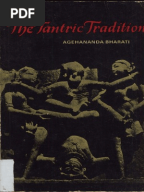The Agamas
- Mahanirvana, Kularnava, Kulasara, Prapanchasara, Tantraraja, Rudra-Yamala, Brahma-Yamala, Vishnu-Yamala and Todala Tantra are the important works. The Agamas teach several occult practices some of which confer powers, while the others bestow knowledge.
- The main points to emphasise here are the following: the measuring and tracing of the mandala is performed using impure substances, befitting a transgressive Bhairava-tantra; the core pantheon is located on a lotus in the centre around which an intricate pattern of eight passageways (vithi) is to be constructed, with their open gates placed in.

An article bySri Swami Sivananda, the founder of Divine Life Society

The texts are usually in the form of dialogues between Shiva and Parvati. In some of these, Shiva answers the questions put by Parvati answers, Siva questioning, Mahanirvana, Kularnava, Kulasara, Prapanchasara, Tantraraja, Rudra Yamala, Brahma Yamala, Vishnu Yamala, and Todala Tantra are the important works. Aspects of Agama. Agama deals with three phenomena, Mantra Yantra and Tantra. Mantra is the sound-form of God-form and is often used synonymously to Devata.It is the means/basis for both Yantra and Tantra. Yantra is basically a contrivance, charged with the power of a mantra.It could be a geometric shape as in case of devata yantra or just any instrument as in case of an astra. List of all Brahma Yamala Tantra stotrams below. Change the stotram title from English to 'Telugu, Sanskrit, Hindi, Tamil, Kannada, Gujarati, Oriya, Punjabi & Malayalam using the options at bottom right side for easy navigation in your local language.
Introduction
Another class of popularscriptures are the Agamas. The Agamas are theological treatises and practicalmanuals of divine worship. The Agamas include the Tantras, Mantrasand Yantras. These are treatises explaining the external worship of God,in idols, temples, etc. All the Agamas treat of (i) Jnana or Knowledge,(ii) Yoga or Concentration, (iii) Kriya or Esoteric Ritual and(iv) Charya or Exoteric Worship. They also give elaborate details aboutontology and cosmology, liberation, devotion, meditation, philosophy of Mantras,mystic diagrams, charms and spells, temple-building, image-making, domesticobservances, social rules, public festivals, etc.
Divisions of theAgamas

The Agamas are divided intothree sections: the Vaishnava, the Saiva and the Sakta. Thethree chief sects of Hinduism, viz., Vaishnavism, Saivism and Saktism, basetheir doctrines and dogmas on their respective Agamas. The Vaishnava Agamas orPancharatra Agamas glorify God as Vishnu. The Saiva Agamas glorify God as Sivaand have given rise to an important school of philosophy known asSaiva-Siddhanta, which prevails in South India, particularly in the districts ofTirunelveli and Madurai. The Sakta Agamas or Tantras glorify God as the Motherof the Universe, under one of the many names of Devi.
The Agamas do not derive theirauthority from the Vedas, but are not antagonistic to them. They are all Vedicin spirit and character. That is the reason why they are regarded asauthoritative.
Vaishnava Agamas
The Vaishnava Agamas are offour kinds: the Vaikhanasa, Pancharatra, Pratishthasara and Vijnanalalita. TheBrahma, Saiva, Kaumara, Vasishtha, Kapila, Gautamiya and the Naradiya are theseven groups of the Pancharatras. The Naradiya section of the Santi-Parva of theMahabharata is the earliest source of information about the Pancharatras.
Vishnu is the Supreme Lord inthe Pancharatra Agamas. The Vaishnavas regard the Pancharatra Agamas to be themost authoritative. They believe that these Agamas were revealed by Lord VishnuHimself. Narada-Pancharatra says: 'Everything from Brahman to a blade ofgrass is Lord Krishna.' This corresponds to the Upanishadic declaration:'All this is, verily, Brahman—Sarvam Khalvidam Brahma.'

There are two hundred andfifteen of these Vaishnava texts. Isvara, Ahirbudhnya, Paushkara, Parama,Sattvata, Brihad-Brahma and Jnanamritasara Samhitas are the important ones.
Saiva Agamas
The Saivas recognisetwenty-eight Agamas, of which the chief is Kamika. The Agamas are also the basisof Kashmir Saivism which is called the Pratyabhijna system. The latter works ofPratyabhijna system show a distinct leaning to Advaitism. The Southern Saivism,i.e., Saiva Siddhanta, and the Kashmir Saivism, regard these Agamas as theirauthority, besides the Vedas. Each Agama has Upa-Agamas. Of these, onlyfragmentary texts of twenty are extant. Lord Siva is the central God in theSaiva Agamas. They are suitable to this age, Kali Yuga. They are open to allcastes and both the sexes.

Sakta Agamas
Brahma Yamala Tantra Pdf Free
There is another group ofscriptures known as the Tantras. They belong to the Sakta cult. Theyglorify Sakti as the World-Mother. They dwell on the Sakti (energy)aspect of God and prescribe numerous courses of ritualistic worship of theDivine Mother in various forms. There are seventy-seven Agamas. These are verymuch like the Puranas in some respects. The texts are usually in the form ofdialogues between Siva and Parvati. In some of these, Siva answers the questionsput by Parvati, and in others, Parvati answers, Siva questioning. Mahanirvana,Kularnava, Kulasara, Prapanchasara, Tantraraja, Rudra-Yamala, Brahma-Yamala,Vishnu-Yamala and Todala Tantra are the important works. The Agamas teachseveral occult practices some of which confer powers, while the others bestowknowledge and freedom. Sakti is the creative power of Lord Siva. Saktism isreally a supplement to Saivism.
Brahma Yamala Tantra Pdf Converter
Among the existing books on theAgamas, the most famous are the Isvara-Samhita, Ahirbudhnya-Samhita,Sanatkumara-Samhita, Narada-Pancharatra, Spanda-Pradipika and theMahanirvana-Tantra.